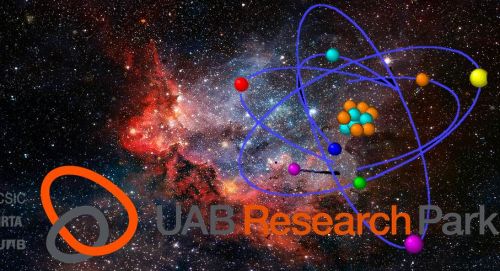
26/07/2017
El Parc de Recerca de la UAB: de l’infinitament petit a l’infinitament gran
El Parc de Recerca de la UAB: de l’infinitament petit a l’infinitament gran
El Parc de recerca de la UAB (PRUAB), del qual el Barcelona Synchrotron Park és soci i patrocinador del programa de generació d’idees, ens ofereix aquest mes dues notícies relacionades amb dos dels seus centres de recerca que treballen en camps situats als dos extrems de l’escala de dimensions: l’Institut Català de Nanociència i Nanotecnologia (ICN2) i l'Institut de Física d'Altes Energies (IFAE).
L’infinitament petit:
Un equip de recerca dirigit per Jordi Sort, professor del Departament de Física de la Universitat Autònoma de Barcelona, amb la col·laboració de l’ICN2, ha desenvolupat un material nanoporós basat en un aliatge de coure i níquel que presenta una estructura similar a la d’una esponja però on els porus tenen separacions de només 5 o 10 nanòmetres, és a dir, que a les parets dels porus només hi ha lloc per a unes desenes d’àtoms. El descobriment d’aquest nou material amb propietats magnètiques, que s’acaba de publicar, podrà permetre en un futur manipular i enregistrar informació amb molt poca despesa energètica per part dels ordinadors. “Això suposa un nou paradigma per a l’estalvi energètic en els ordinadors i en la computació i manipulació de dades magnètiques en general” ha comentat Jordi Sort.
L’infinitament gran:
L’IFAE celebra aquest mes el seu aniversari: 25 anys explorant les fronteres còsmiques i de les altes energies per tal de resoldre les preguntes fonamentals sobre l'univers que encara no tenen resposta. Les línies de recerca principals, tant experimentals com teòriques, són la física de partícules, l'astrofísica d'altes energies i la cosmologia. La innovació tecnològica, però, és també present a l’IFAE en els projectes de física aplicada: desenvolupament de nova instrumentació, com ara detectors o càmeres de telescopis, projectes d’aplicacions en medicina, com nous sistemes d’imatge mèdica, i solucions de gestió massiva de dades.
L’infinitament petit:
Un equip de recerca dirigit per Jordi Sort, professor del Departament de Física de la Universitat Autònoma de Barcelona, amb la col·laboració de l’ICN2, ha desenvolupat un material nanoporós basat en un aliatge de coure i níquel que presenta una estructura similar a la d’una esponja però on els porus tenen separacions de només 5 o 10 nanòmetres, és a dir, que a les parets dels porus només hi ha lloc per a unes desenes d’àtoms. El descobriment d’aquest nou material amb propietats magnètiques, que s’acaba de publicar, podrà permetre en un futur manipular i enregistrar informació amb molt poca despesa energètica per part dels ordinadors. “Això suposa un nou paradigma per a l’estalvi energètic en els ordinadors i en la computació i manipulació de dades magnètiques en general” ha comentat Jordi Sort.
L’infinitament gran:
L’IFAE celebra aquest mes el seu aniversari: 25 anys explorant les fronteres còsmiques i de les altes energies per tal de resoldre les preguntes fonamentals sobre l'univers que encara no tenen resposta. Les línies de recerca principals, tant experimentals com teòriques, són la física de partícules, l'astrofísica d'altes energies i la cosmologia. La innovació tecnològica, però, és també present a l’IFAE en els projectes de física aplicada: desenvolupament de nova instrumentació, com ara detectors o càmeres de telescopis, projectes d’aplicacions en medicina, com nous sistemes d’imatge mèdica, i solucions de gestió massiva de dades.
Més notícies
15/01/2016
Parc Tecnològic del Vallès: arribada de FERRER i acreditació de SEVIBE CELLS
08/01/2016
Campionats d’Espanya de duatló: no només els electrons donen voltes al Barcelona Sychrotron Park
17/12/2015
Catalunya, la primera regió d’Europa continental en atracció d’inversions estrangeres en R+D
11/12/2015
El 4t programa de generació d'idees del PRUAB ja té guanyadors
03/12/2015
Les tecnologies de SENER a l’actualitat internacional
25/11/2015
Applus+ es reforça al sector aeroespacial









